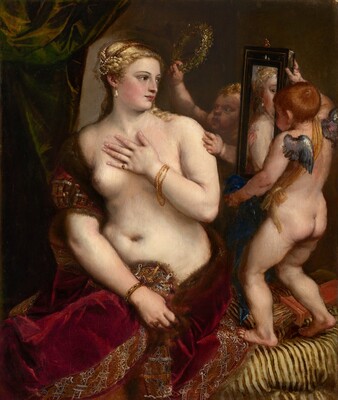The viewer, seeing her face in the mirror, may naturally assume that Venus is looking at herself.
The effect gets its name from several old master paintings, including this one by Diego Velázquez.
 |
| Velázquez's Rokeby Venus |
 |
| Veronese's Venus with a Mirror |
If she were really looking at herself, we probably wouldn't see her face in the mirror at all (unless we were looking directly over her shoulder).
Titian's Venus with a Mirror is even more wildly off-angle.
 |
| Peter Paul Rubens' Venus at the Mirror, c. 1614–15. |
Given these eye lines, Miss Venus would have to be looking at us, the viewer. That's the way the Rubens looks to me. I read it as her looking at me as I accidentally break into her dressing room. But I think Rubens and his audience interpreted the painting as Venus looking at herself.
The Venus Effect also shows up in cinema, where an actor looks at their mirror reflection. Their head position and gaze direction are often "cheated" so that we can see their face in the mirror without also seeing the camera.
Venus Effect on Wikipedia








4 comments:
This effect seems to be "off" because the angles never do read properly. Even to a casual observer.
I thought it was just a subliminal twisted vanity lesson, since most of these are women. The woman is still always having to present herself for the (assumed) male gaze. Not herself.
This reminds me of a demo by Norman Rockwell in the Famous Artists course. One of his scrap photos shows a model holding a mirror under his chin. Rockwell explains that his intent was to get the reflection of the model standing up to his chin in water. However due to the angle of reflection nothing showed up in the mirror.
The other thing that's always bugged me about the Velazquez Venus (as well as the Rubens, which I hadn't seen before) is the head size. Doesn't the reflection in the mirror follow the rules of perspective, and so, being closer to the vanishing point, be smaller (not larger) than the subject?
It's just a way to put in a painting both a full body nude and a portrait.
The frame of the mirror with the face reflection is a picture inside a picture.
The angle isn't correct, but the overall effect is nice.
I also think that mr. Rubens did that intentionally, taking a usual composition to produce a different feeling to the viewer. Very intriguing.
Post a Comment